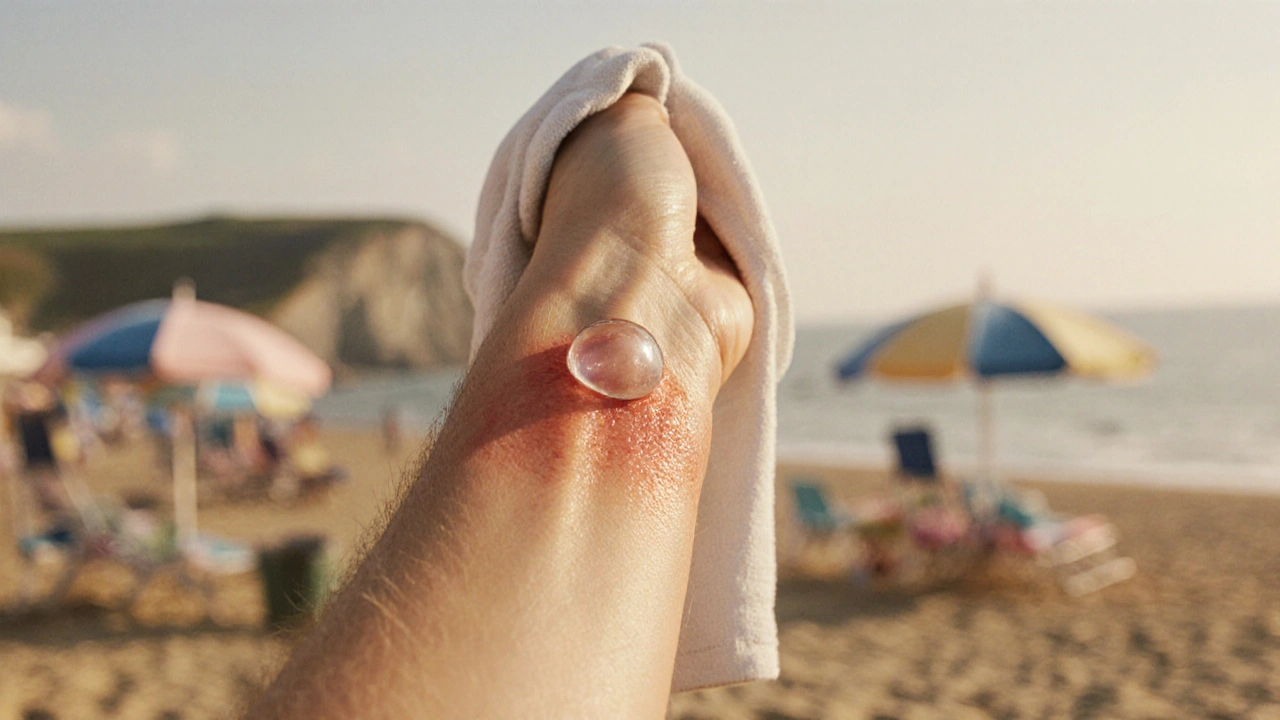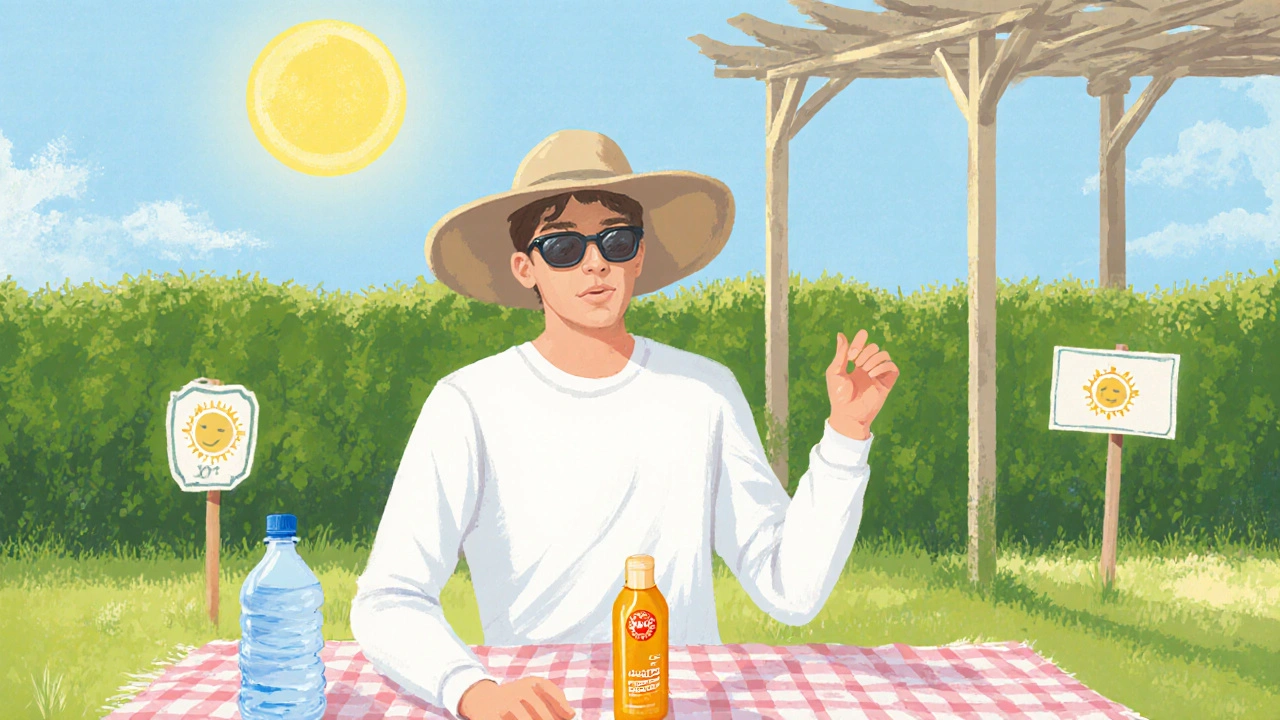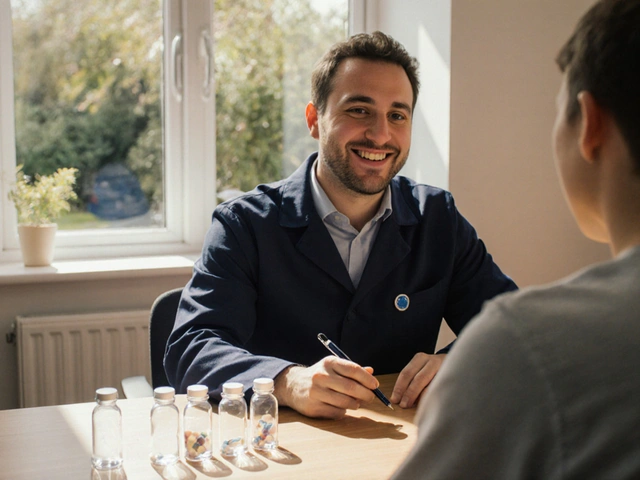
Sunburn Blister Care Calculator
Recommended Treatment Plan
Quick Summary
- Cool the area with a gentle compress within the first hour.
- Leave blisters intact; they act as natural dressings.
- Apply soothing agents like aloe vera or a hydrocolloid dressing.
- Stay hydrated and protect the skin from further UV exposure.
- Seek medical help if blisters cover large areas or show signs of infection.
What Exactly Are Sunburn Blisters?
When your skin endures an intense UV onslaught, the upper layer, the Sunburn Blister is a small pocket of fluid that forms between the damaged epidermis and the underlying dermis. This fluid cushions the injured tissue and prevents air from drying it out. Think of it as the body’s own band‑aid.
The epidermis is the outermost skin layer that provides the first line of defense against environmental stressors. When UV radiation overwhelms its capacity, cells swell, release inflammatory mediators, and the blister appears as a visible warning sign.
sunburn blisters can feel tight, painful, and look unsightly, but with the right approach they heal quickly and without scarring.
First‑Hour Actions: Stop the Damage in Its Tracks
Time matters. The quicker you cool the skin, the less swelling and pain you’ll experience.
- Cool compress: Soak a clean cloth in lukewarm (not icy) water, wring out excess, and gently lay it on the affected area for 10‑15 minutes. Repeat every hour for the first three hours.
- Hydration: Drink at least 2‑3 liters of water throughout the day. Proper hydration supports skin regeneration and prevents the blister fluid from thickening.
- Pain relief: Over‑the‑counter ibuprofen or paracetamol reduces inflammation and eases discomfort. Follow the dosage instructions on the package.
Avoid hot showers, harsh soaps, or rubbing the blister-these actions can rupture the skin prematurely.

Choosing the Right Treatment: From Nature to Modern Dressings
Once the initial cooling phase is over, you have several safe options to promote healing. Below is a quick‑look comparison.
| Remedy | Primary Action | Pain Relief | Typical Healing Time | Cost (UK) |
|---|---|---|---|---|
| Aloe Vera Gel | Soothes inflammation, provides moisture | Mild | 2‑4 days | £3‑£6 |
| Hydrocolloid Dressing | Creates moist environment, protects from infection | Moderate | 3‑5 days | £5‑£12 per pack |
| OTC Burn Cream (e.g., ibuprofen‑infused) | Reduces inflammation, forms barrier | Moderate | 3‑5 days | £4‑£8 |
| Cool Compress Only | Reduces heat, limits swelling | Low | 4‑7 days | Free |
| Moisturising Lotion (Fragrance‑free) | Prevents drying, supports skin barrier | Low | 5‑7 days | £2‑£5 |
Natural Soothers
Aloe vera is a succulent plant whose gel contains polysaccharides, vitamins, and anti‑inflammatory compounds. Apply a thin layer of pure gel (or a store‑bought, additive‑free product) after cleaning the skin with cool water. Re‑apply every 2‑3 hours while the blister remains intact.
Why it works: The gel draws excess fluid out of the blister, reduces redness, and creates a protective film that discourages bacteria.
Modern Dressings
Hydrocolloid dressing is a soft, adhesive patch made of gel‑forming particles that lock in moisture and shield the wound from contaminants. Cut the dressing to fit the blister, peel off the backing, and press gently. Change it every 2‑3 days or if it becomes saturated.
Benefits: The moist environment speeds up cellular migration, lessens scarring risk, and most people find the dressing virtually painless.
Pharmacy‑Grade Creams
Products containing lidocaine, benzocaine, or ibuprofen can dull the pain and curb inflammation. Apply a pea‑sized amount, massage lightly, and avoid rubbing the blister itself.
Watch out: Over‑application can cause skin irritation; stick to the recommended amount.
Moisturising Lotions
A fragrance‑free, hypoallergenic lotion (e.g., ceramide‑rich formulas) keeps the surrounding skin supple, preventing the blister from cracking as it dries.
Use the lotion after the blister has started to re‑absorb fluid-typically after 24‑48hours.
Do’s and Don’ts: A Quick Checklist
- Do keep the blister clean with cool water; pat dry gently.
- Do protect the area with a breathable dressing if you need to go outside.
- Do stay hydrated and replenish electrolytes.
- Don’t pop or puncture the blister; it raises infection risk.
- Don’t apply greasy ointments (petroleum jelly) on a fresh blister; they trap heat.
- Don’t expose the skin to direct sunlight again until fully healed.
When to Call a Doctor
Most blisters heal on their own, but certain signs warrant professional care:
- Blisters covering more than 10% of the body surface.
- Intense throbbing pain that isn’t relieved by OTC meds.
- Fluid that turns yellow, green, or foul‑smelling-possible infection is a bacterial invasion that can cause cellulitis, fever, and spreading redness.
- Signs of dehydration: dizziness, dry mouth, reduced urine output.
- Any underlying condition that weakens immunity (diabetes, eczema, etc.).
Medical providers may prescribe oral antibiotics, sterile dressings, or in severe cases, perform a minor debridement.
Prevent Future Sunburn Blisters
Prevention is simpler than treatment. Here are practical tips:
- Broad‑spectrum sunscreen: Choose SPF30 or higher, reapply every two hours, and after swimming.
- Protective clothing: UPF‑rated shirts, wide‑brim hats, and sunglasses reduce UV exposure.
- Seek shade: Between 11am and 3pm the sun’s rays are strongest.
- Stay hydrated: Carry a water bottle wherever you go.
- Know your skin type: Fair skin burns faster; consider extra layers of protection.
By building a habit of daily sunscreen use, you’ll dramatically cut the odds of blister‑forming sunburns.

Frequently Asked Questions
Can I safely pop a sunburn blister at home?
No. Popping removes the natural barrier that protects the underlying skin, increasing infection risk. Let it burst naturally or be handled by a healthcare professional.
How long do sunburn blisters typically last?
Most blisters resolve within 5‑7days if kept clean and covered. Larger or deeper blisters may need a week or more.
Is it okay to use regular acne cream on a blister?
Generally not. Acne creams often contain salicylic acid or benzoyl peroxide, which can irritate the delicate blister skin and delay healing.
Should I apply ice directly to the blister?
Avoid direct ice; it can cause frostbite. Stick to a cool, damp cloth or a refrigerated gel pack wrapped in a thin towel.
Can sunburn blisters cause scar tissue?
If the blister ruptures and the wound isn’t cared for, scarring can occur. Keeping the blister intact and using a moist dressing greatly reduces that risk.






Nilesh Barandwal
October 3, 2025 AT 05:20Wow!!! Sunburn blisters are no joke, but with the right steps you can turn the pain into a quick recovery!!!
Elise Smit
October 6, 2025 AT 05:20Great guide! I especially appreciate the emphasis on keeping the blister intact and using aloe vera; those are simple steps that make a big difference.
Sen Đá
October 9, 2025 AT 05:20While the article is generally accurate, it neglects to mention that topical antibiotics such as bacitracin may be warranted when the blister becomes compromised, and this omission could lead readers to under‑treat a potentially serious infection.
LEE DM
October 12, 2025 AT 05:20I like the quick‑summary list; it’s exactly what a busy person needs when they’ve just gotten burned at the beach.
mathokozo mbuzi
October 15, 2025 AT 05:20It is recommended that individuals monitor for signs of infection, such as erythema or purulent discharge, and seek medical attention promptly should these symptoms arise.
Penny X
October 18, 2025 AT 05:20One must remember that neglecting proper sun protection is a reckless disregard for one’s own health, and the failure to apply sunscreen before prolonged exposure is, frankly, irresponsible.
Calandra Harris
October 21, 2025 AT 05:20Hydrocolloid dressings work because they maintain a moist environment which promotes faster re‑epithelialisation.
Dan Burbank
October 24, 2025 AT 05:20Sunburn blisters are nature’s bitter reminder that we have overstepped the boundaries of safe sunlight exposure. The fluid‑filled sac that forms is, in fact, a protective cushion for the damaged epidermis. Yet, many people mistakenly pop these blisters, believing they are expediting healing. This act, however, shatters the natural barrier and invites bacterial invasion. Studies have shown that intact blisters heal with less scarring and lower infection rates. Therefore, the first rule is simple: do not puncture. Apply a cool, damp cloth for ten minutes, and repeat periodically to reduce inflammation. Aloe vera gel, rich in polysaccharides, draws excess fluid and soothes the burn. If the blister is large, a hydrocolloid dressing provides a sterile, moist environment that accelerates cellular migration. Over‑the‑counter analgesics such as ibuprofen mitigate pain and curb systemic inflammation. Hydration is equally crucial; water supports the skin’s regenerative processes. Avoid tight clothing that can rub against the blister and cause rupture. Keep the affected area out of direct sunlight until fully healed, applying sunscreen only after recovery. Should any sign of infection appear-yellow discharge, foul odor, increasing redness-consult a healthcare professional without delay. By respecting the body’s own healing mechanisms, one can emerge from a sunburn episode with minimal lasting damage.
Anna Marie
October 27, 2025 AT 04:20Honestly, the checklist you provided hits all the right notes; staying hydrated and shielding the skin are fundamentals that most of us overlook until it’s too late.
Abdulraheem yahya
October 30, 2025 AT 04:20Yo, I was out there hitting the surf last weekend and totally misjudged the UV index, ended up with a couple of nasty blisters that throbbed like tiny drums; after reading this, I realized I should’ve slapped on some aloe ASAP and maybe a hydrocolloid patch, but I went straight for a greasy ointment which just made it feel like I was sealing in the heat-big mistake! The cool compress thing sounded simple, but I was too lazy to keep a wet towel handy, so the pain just lingered. Hydration? I was sipping soda, not water, which didn’t help the skin recover. This post reminded me that a proper approach-cool water, proper dressings, and staying out of the sun until it’s healed-makes all the difference. Next time, I’m packing a small first‑aid kit with the right stuff; trust me, your skin will thank you.
Preeti Sharma
November 2, 2025 AT 04:20While the article promotes leaving blisters untouched, there are scenarios where sterile drainage performed by a professional can actually reduce healing time and discomfort.
Miriam Bresticker
November 5, 2025 AT 04:20Yaa, thx!! 😊 ths guide is super helpful!! just dont forget 2 drink water!! 💦
Claire Willett
November 8, 2025 AT 04:20Implementing a tiered protocol-cool compress, hydrocolloid, analgesic-optimizes re‑epithelialisation kinetics.
olivia guerrero
November 11, 2025 AT 04:20Wow!!! That's exactly the kind of evidence‑based strategy we need to share with everyone!!! 🌞
Dominique Jacobs
November 14, 2025 AT 04:20Man, you nailed it-those quick tips are the real MVPs when you’re burning up at the beach.